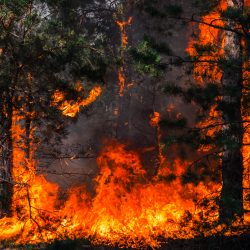By Robert Perry, Director of Energy Research
(This is a two-part series by Robert Perry exploring how California’s climate change induced fire threats presents a replicable opportunity for economic growth and social justice)
The Gulf Coast has its hurricanes. The East Coast, torrential rainfall (and sometimes hurricanes). For California, the primary threat from climate change is wildfire, and there are 129 million dead trees waiting to go up in flames (hopefully, not all at once).
The Thomas Fire’s notoriety as California’s largest wildfire lasted seven months, and the title currently held by the Mendocino Complex Fire will likely not last as long. Future fires will only get bigger, and there is a distinct possibility that a major portion of the Sierras could become engulfed in flames, eliminating much of the forest that preserves the precious winter snowpack providing us with water, and life.
I recently listened to a multi-agency workshop on Climate Adaptation and Resiliency and the central theme throughout the six-hour event was the wildfire threat. Representatives from California’s Energy Commission (CEC), Public Utilities Commission (CPUC), Natural Resources Agency (CNRA), Governor’s Office of Planning and Research (GOPR), and Governor’s Office of Emergency Services (GOES) gave presentations and discussed “changes in the risk of wildfire due to climate change in California and how the energy sector can prepare.”
Understandably, most of the strategic elements centered around protecting the energy grid and vulnerable communities, though there are a number of positive steps being taken towards reducing the fire threat. Earlier this year, Governor Brown issued Executive Order B-52-18, which supports implementation of the Forest Carbon Plan, calls for doubling forest improvement treatments on nonfederal lands from 250,000 acres/year to 500,000 acres, and seeks to reduce regulatory barriers and support wood product innovation, including a Joint Institute for Wood Products Innovation.
Jana Ganion, Sustainability & Government Affairs Director of the Blue Lake Rancheria tribe, who operates one of the few fully functional community microgrids currently in existence, spoke of the advantages of micro-grids in supplying electricity to fire-prone areas, and the aggressive climate actions needed to reduce wildfires. In her presentation, she recommended the removal of biomass generation as part of California’s Renewable Portfolio Standard Program. She points to converting forest residue into biochar as a soil amendment to support the replanting and growth of indigenous trees and other plants. It is also clear that remote rural communities in fire hazard zones should be redeveloped as standalone community micro-grids, in an effort to retire some of the 40 high-voltage transmission lines that currently run through hazardous timber zones.
Related: Montecito Community Microgrid Initiative Established
One fact that can’t be debated is the sheer scale of the problem. 129 million dead trees is a massive amount of timber (or firewood given the worst case scenario), and this threat should be seen as an opportunity to manage a valuable resource utilizing advanced technologies. According to the presentation by Guido Franco, David Stoms, and Susan Wilhelm of the CEC, “[t]he large number of dead trees has no historical precedent,” and “[t]here is a potential for mass fires that burn extremely hot but slowly.”
As Bill McKibben wrote on August 15, 2016 in A World at War: “World War III is well and truly underway. And we are losing…The question is not, are we in a world war? The question is, will we fight back? And if we do, can we actually defeat an enemy as powerful and inexorable as the laws of physics?”
There’s no argument in the scope and brevity required for successful mitigation. Our vulnerabilities are formidable and transparent – however, since history tends to repeat itself, there is cause for optimism. We were victorious in WWII and the FDR Days delivered us out of the Great Depression, while producing some of the biggest infrastructure expansions in history. It truly was the Greatest Generation, and we would all greatly benefit if more people begin to adopt that gritty “can-do” attitude and selfless sense of purpose.
The enormous challenges presented by today’s climate crisis, requires that type of determination. I believe Millennials understand the problems they’ve inherited, and it’s time to let them lead us into a more sustainable future. The rest of us need to become the support act for their vision. We need to allow them every opportunity to demonstrate the creativity and hope of their generation and award them whatever they ask – so they may guide us away from the apathetic environmental policies of yesteryear.
The battle against fire hazards calls for collaboration, innovative solutions, and a healthy amount of automation – supervised by experienced operations crews. If we can achieve this, it is possible that we could accelerate the harvesting of usable timber and convert the remaining forest residue into biochar to support regrowth.
Jana Ganion, Sustainability & Government Affairs Director of the Blue Lake Rancheria tribe, likened the situation of the multi-state effort to combatting the Dust Bowl. And she’s right – a large-scale, coordinated effort, in addition to the funding (and manpower) needed to execute – is the only way we’re going to win this war.
Check back on Friday, September 7th for the next installment of Thinking Beyond the Burn, where we explore opportunities presented by this urgent need to reduce California’s wild fire risk.

